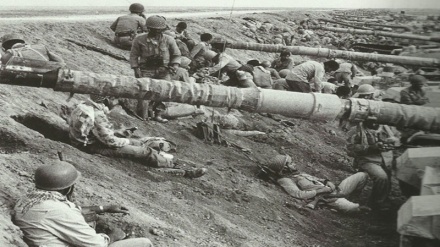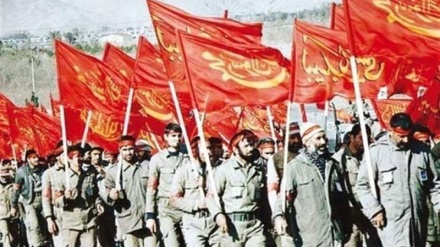Glimpses of Epic of the 8-Year Holy Defense (78)
In the previous episode, we discussed the change of equation in war to the benefit of Saddam. You heard that the Faw Peninsula was retaken by Saddam as a result of the US all-out support for the Iraqi dictator and the state-of-the-art weapons and military equipment which were generously given to the Ba’athist army by the Western and the Eastern powers and their satellites.
Another reason for the fall of the strategic region of Faw was the fact that the Iranian forces were mainly stationed in along the West of the country some 1,000 kilometers away from the Southwest. Brigadier General Gholamali Rashid said a few months after the fall of Faw, “Every move of the Iraqi Ba’athist army was in our mind as a strategy. We were overwhelmed with three thoughts. Firstly, the wrong analysis of the casualties of enemy in 1986 and 1987 which caused the highest loss for us; secondly, the dead-end in the Southern fronts and going to the Northwest; and most importantly, the lack of thinking on a change in the enemy’s strategy. Meanwhile, the presence of the Iranian forces in the Northwest, 1,000 kilometers away from Faw, as the change of Iran’s strategy, was a very important issue; because the Iranian command, logistics and forces were stationed in the Southern fronts. The flatness of the ground, closeness of the fronts, repetition of a series of attack and counterattack operations on the ground and removal of weak points and shortages led to Iran’s superiority over Iraq; while this was not the case in the Northwest. Therefore, the time was ripe for Saddam’s regime to transfer his forces and facilities to the South. This was the very opportunity that Iraq was looking for. The American daily New York Times referred to the issue later on when it wrote that the Iranian commanders in Faw never thought that the Iraqis would intend or be able to attack their strong defensive positions; and Iraq exploited this wrong sense of security and surprised the Iranians.
After the fall of Faw, as a beginning to end the war, many views were raised on the fall of this strategic region. Some maintained that Faw fell due to the lack of enough military forces on Iran’s side to encounter Iraqi attacks. Due to the stalemate in the Southern fronts for launching a surprise and successful operation, the only way to keep military superiority was to launch operations in the Northwest. In view of this, in the autumn of 1987 and winter of 1988, several operations were launched in the Northwest. Now the question is: Had these operations not been launched and the forces had been kept concentrated in the South, could the Iraqi army have been able to carry out serial attacks in the region and retake several regions from Iran?
With regards to the circumstances in the Southern region, Iran had three ways to choose. Firstly, based on the likelihood of the enemy’s eventual assault in the South, Iran could get necessary preparedness to confront Iraq through limited offensives there. But, this solution couldn’t be that effective since the specific area for the Iraqi attack was not known. However, adoption of the strategy of counterattack was impossible as it was not feasible to mobilize Basiji forces as the core of the operational forces in the short-term. The second way was to launch operations in the Northwest with the hope that Iraq would transfer army units to the region. But this didn’t happen in a significant scale. The third way was to set up peace which was underway in the foreign ministry through political and diplomatic efforts on the articles of United Nations Security Council Resolution 598.
Due to the improvement of the Ba’athist army’s combat ability with the direct support of the US, the Soviet Union and their allies, the concentration of the Iranian forces in the Southern front had no determining role to the favour of Iran in case of an Iraqi offensive.
The developments after the fall of Faw showed that the Americans had decided to help Saddam with the aim of ending the war. That’s why, concurrent with the Iraqi army’s attack to retake Faw, the US warships on April 18, 1988, in reaction to their warship Samuel B Robins’ hitting a sea mine in the Persian Gulf, attacked two Iranian oil rigs Salman and Nasr and destroyed them totally. Iran’s oil installations, especially these rigs, were very vulnerable against the attacks of US warships because the Iranian air and navy forces couldn’t safeguard them. Nearly three hours later, the US criminal forces targeted three warships of Jowshan, Sahand and Sabalan, belonging to the Iranian Army’s Navy, with Harpoon missiles and drowned them. 64 navy personnel were martyred during the attack. After these clashes, Washington announced that its war flotilla would support all vessels commuting in the Persian Gulf.
In such conditions, European countries assisted the US in clearing the waters of the region of mines. The United States was highly dependent on its regional bases for such attacks, particularly the Saudi and Kuwaiti bases. Kuwait, besides disposing its port installations to the US, spent the expenses of hiring the frigates used by the US in the Persian Gulf. Furthermore, it would provide the American war flotilla with 9 million barrels of fuel per month. The US warships would use the Saudi ports for fueling and other services. Bahrain, too, was the base of the American helicopters and aircrafts. The American aircrafts would use the UAE and Omani airspace, as well. In short, the Arab regimes of the region were totally at the service of the Great Satan (the US) against Iran.
RM/SS


